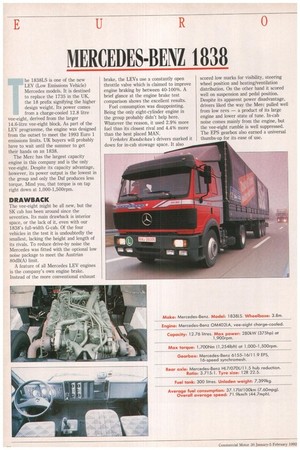MERCEDES-BENZ 1838
Page 38

If you've noticed an error in this article please click here to report it so we can fix it.
The 1838LS is one of the new LEV (Low Emissions Vehicle) Mercedes models. It is destined to replace the 1735 in the UK, the 18 prefix signifying the higher design weight. Its power comes from a charge-cooled 12.8 litre vee-eight, derived from the larger 14.6-litre vee-eight block. As part of the LEV programme, the engine was designed from the outset to meet the 1993 Euro 1 emissions limits. UK buyers will probably have to wait until the summer to get their hands on an 1838.
The Merc has the largest capacity engine in this company and is the only vee-eight. Despite its capacity advantage, however, its power output is the lowest in the group and only the Daf produces less torque. Mind you, that torque is on tap right down at 1,000-1,500rpm.
DRAWBACK
The vee-eight might be all new, but the SK cab has been around since the seventies. Its main drawback is interior space, or the lack of it, even with our 1838's full-width G-cab. Of the four vehicles in the test it is undoubtedly the smallest, lacking the height and length of its rivals. To reduce drive-by noise the Mercedes was fitted with the optional low noise package to meet the Austrian 80dB(A) limit.
A feature of all Mercedes LEV engines is the company's own engine brake. Instead of the more conventional exhaust brake, the LEVs use a constantly open throttle valve which is claimed to improve engine braking by between 40-100%. A brief glance at the engine brake test comparison shows the excellent results.
Fuel consumption was disappointing. Being the only eight-cylinder engine in the group probably didn't help here. Whatever the reason, it used 2.9% more fuel than its closest rival and 4.4% more than the best placed MAN.
Verkehrs Rundschau's drivers marked it down for in-cab stowage space. It also
scored low marks for visibility, steering wheel position and heating/ventilation distribution. On the other hand it scored well on suspension and pedal position. Despite its apparent power disadvantage, drivers liked the way the Merc pulled well from low revs — a product of its large engine and lower state of tune. In-cab noise comes mainly from the engine, but the vee-eight rumble is well suppressed. The EPS gearbox also earned a universal thumbs-up for its ease of use.
















































































